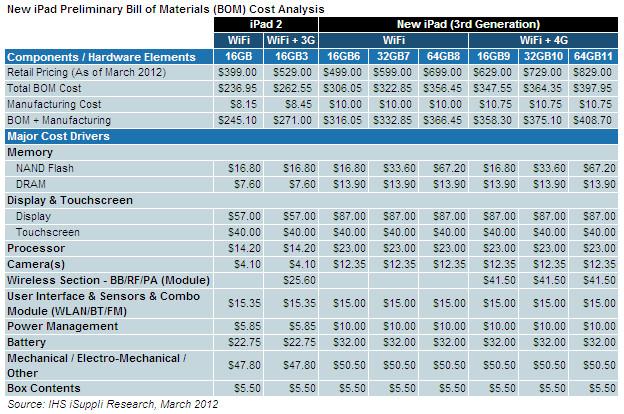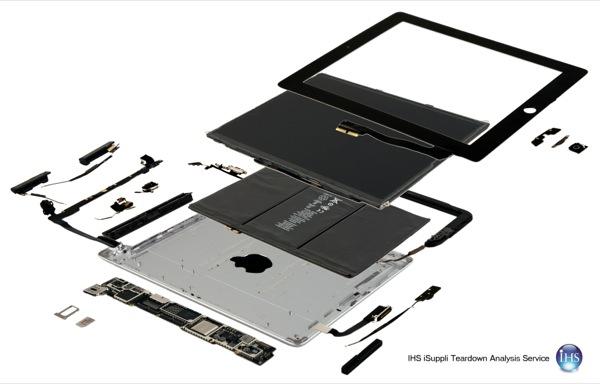Market research firm IHS iSuppli on Friday released a report detailing the component cost associated with building the new iPad, and found that the prices of a few key components are costing Apple a substantial amount in profit per unit.
At the time of launch, the preliminary bill of materials (BOM) of a 32GB Wi-Fi + 4G LTE iPad is $364.35 which, when adding in the $10.75 in manufacturing costs, represents 50 percent of the tablet's $729 retail price. In comparison, when the iPad 2 was launched, the BOM of a 32GB Wi-Fi + 3G version was approximately $335.
Because Apple maintains a static pricing strategy when new versions of existing product lines are released, the company will see a drop in profit margin that varies depending on the model.
While the suppliers of the new iPad's internals hasn't changed much from last year's iPad 2, the material cost has spiked for some parts, such as the Retina Display which is the most expensive component in the tablet. Samsung was the largest supplier and provided two of the priciest parts with the $87 display and the A5X processor, which costs an estimated $23. The combined cost of these two parts alone gives the South Korean electronics giant a 30.2 percent share of the 32GB iPad's BOM.
It should be noted that Apple designed the A5X processor and thus holds the intellectual property associated with the component. Samsung is only manufacturing the part for the Cupertino, Calif., company and is thus not able to charge as much as an independent semiconductor supplier.
Breakdown of the new iPad's preliminary BOM compared to iPad 2. | Source: IHS iSuppli
Although it was not plainly demarcated, the battery cell package is thought to be a Samsung product as well, which brings the company's share of BOM to nearly 50 percent.
Qualcomm is furnishing the third-generation tablet's baseband chip, while Broadcom is supplying the device's Bluetooth and Wi-Fi radios. Additional wireless components are supplied by TriQuint Semiconductor. Also making a return are STMicroelectronics and Cirrus Logic, tapped to provide the iPad's gyroscope and audio codec processor, respectively.
The biggest money-maker in any iDevice is the NAND flash memory as consumer demand has allowed Apple to make immense profits through huge contracted deals. For the latest iPad, Apple sourced NAND from multiple parties including Samsung, Toshiba and Hynix.
"The NAND flash memory is one of the key profit-generating components for Apple in the new iPad line, as it has been in previous iPads and in the iPhone family,†said Senior Principal Analyst of Teardown Services Andrew Rassweiler. “Apple makes far and away more money in selling consumers NAND flash than NAND flash manufacturers make selling it to Apple. And the more flash in the iPad, the higher the profit margin there is for Apple.â€
Other parts were carry-overs from previous generation Apple products, like the rear-facing camera that was Another key component was the system's NAND flash memory, which was sourced from multiple parties including Samsung, Toshiba and Hynix.">originally used in the iPhone 4 and the front-facing camera which comes from the iPad 2.
Component pricing will come down as iPad production ramps up, and demand for the iPad is such that Apple will most likely make up for the loss in comparative profit margin.
 Mikey Campbell
Mikey Campbell








-m.jpg)






 Brian Patterson
Brian Patterson
 Charles Martin
Charles Martin


 Malcolm Owen
Malcolm Owen
 William Gallagher
William Gallagher
 Christine McKee
Christine McKee
 Marko Zivkovic
Marko Zivkovic







111 Comments
We'll make it up on volume
This is actually o-l-d news. Apple will lose some profit points overall, but with the iPad2 in the mix it will be minimal.
This is actually o-l-d news. Apple will lose some profit points overall, but with the iPad2 in the mix it will be minimal.
Isn't the iPad 2 a bigger lost now, since it still costs the same to produce but it's selling at $100 less.
Isn't the iPad 2 a bigger lost now, since it still costs the same to produce but it's selling at $100 less.
It would have been had this been its launch day, but component costs for the iPad 2 have come down appreciably, so Apple's probably able to make the same profit on it now (at its current price) as they did at its launch.